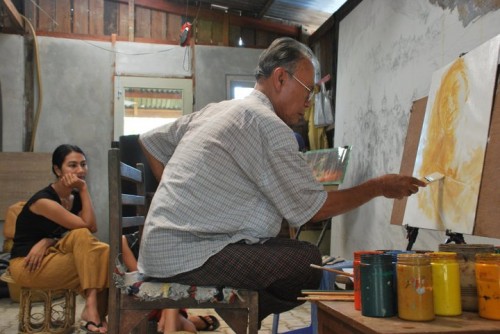A Sketch of Maung Nyo Win: An artist in my inner circle
by Khet Mar / July 25, 2012 / No comments
The fears of being painted by a recorder of history
Whenever I think of my native land and the people there who I love, I think of the painter Maung Nyo Win, whose art is treasured in Burma. People there also respect him for his seriousness and because his face, with its big jaw, is imperturbable. Just the thought of him warms my heart.

- In Burma if you want to hear about issues the newspapers can’t talk about, you should go to a tea shop. Tea houses were where I used to meet with other activists, writers and artists, as well as where I built friendships. Within tea houses we talked about Burmese writers, literary trends we noticed, and, of course, politics. This online space attempts to emulate the conversations I enjoyed in Rangoon’s tea houses.

- Khet Mar is a journalist, novelist, short story writer, poet, and essayist from Burma. She is the author of one novel, Wild Snowy Night, as well as several collections of short stories, essays and poems. Her work has been translated into English and Japanese, been broadcast on radio, and made into a film. She is a former writer-in-residence at City of Asylum/Pittsburgh.
Maung Nyo Win is the son of the famous Burmese artist U Ba Yin Kalay. However he became famous not only because of his father, but also because of his own art.
In the 1960s and 70s, giant paintings were commissioned to advertise movies in Burma. The advertisements were about 100 feet square and covered the front sides of the cinemas. If you walked around downtown, it was almost like an exhibition. Whenever there was a new movie in the theaters, the streets of Yangon were packed with people who had come to see the new posters.
Maung Nyo Win is one of the best known movie poster-painters because his brushstrokes captured the actors’ emotions and elicited strong feelings in people. I remember admiring his posters when I was young, even though I grew up in a rural area and was not familiar with the city’s art world.
When, by fate, I became a writer, I grew even more interested in Maung Nyo Win’s art and found out about one of his extraordinary characteristics. When famous writers, poets, or artists died, Maung Nyo Win would go to the deceased as soon as possible and paint their portrait. He would finish by the light of dawn and then give the painting to the family, accepting no payment. His portraits of the dead are very skillful and alive with the subjects’ experiences. But he doesn’t paint for everyone. He has a rule.
When I decided to write about Maung Nyo Win, I called him and asked about his rule for painting portraits of the dead.
“I look at his or her investment in art and in life and the value people placed on him or her,” he said.
He doesn’t usually paint people who haven’t worked to support the arts and acting, or people whose work has not been acknowledged.
In late 2008, a few months before coming to the United States as a City of Asylum/Pittsburgh writer-in-residence, I suffered from a mental problem: I feared that I would die soon. Before leaving Burma I took a risk and asked Maung Nyo Win to paint my portrait. I felt like I was gambling with my life by doing this, as it was during the time when my mental problem was most severe.
When Maung Nyo Win agreed to paint me I had two strong, but different, feelings simultaneously. One was the thought that I really was going to die soon; the other was that I was honored to be on Maung Nyo Win’s list of portraits.
I stayed with him the whole time that he painted it. I was very excited, but nervous, as I was convinced that I was going to die soon and Maung Nyo Win usually only paints dead people. However, I didn’t die; moreover, I was able to bring my portrait with me to the United States. Whenever I miss my country and my friends, I take a look at this portrait and it fills me with love and pleasure.
Now, because Maung Nyo Win asked only for an investment in art and in life as a fee for the portrait, he is in my inner circle.
Translation: Courtney Wittekind





